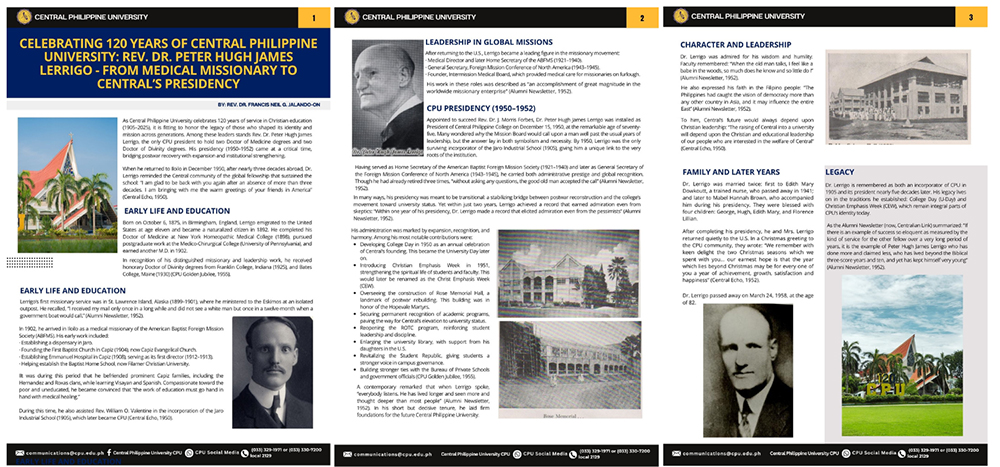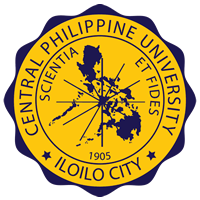Rev. Dr. Francis Neil G. Jalando-on

Central Philippine University commemorates its 120th founding anniversary by honoring Rev. Dr. Peter Hugh James Lerrigo, whose leadership as medical missionary and president (1950–1952) guided CPU’s postwar recovery, institutional growth, and enduring Christian educational mission.
As Central Philippine University celebrates 120 years of service in Christian education (1905–2025), it is fitting to honor the legacy of those who shaped its identity and mission across generations. Among these leaders stands Rev. Dr. Peter Hugh James Lerrigo, the only CPU president to hold two Doctor of Medicine degrees and two Doctor of Divinity degrees. His presidency (1950–1952) came at a critical time, bridging postwar recovery with expansion and institutional strengthening.
When he returned to Iloilo in December 1950, after nearly three decades abroad, Dr. Lerrigo reminded the Central community of the global fellowship that sustained the school: “I am glad to be back with you again after an absence of more than three decades. I am bringing with me the warm greetings of your friends in America” (Central Echo, 1950).
Early Life and Education
Born on October 6, 1875, in Birmingham, England, Lerrigo emigrated to the United States at age eleven and became a naturalized citizen in 1892. He completed his Doctor of Medicine at New York Homeopathic Medical College (1898), pursued postgraduate work at the Medico-Chirurgical College (University of Pennsylvania), and earned another M.D. in 1902.
In recognition of his distinguished missionary and leadership work, he received honorary Doctor of Divinity degrees from Franklin College, Indiana (1925), and Bates College, Maine (1930) (CPU Golden Jubilee, 1955).
Missionary Work in Alaska and the Philippines
Lerrigo’s first missionary service was in St. Lawrence Island, Alaska (1899–1901), where he ministered to the Eskimos at an isolated outpost. He recalled, “I received my mail only once in a long while and did not see a white man but once in a twelve-month when a government boat would call.” (Alumni Newsletter, 1952).
In 1902, he arrived in Iloilo as a medical missionary of the American Baptist Foreign Mission Society (ABFMS). His early work included:
- Establishing a dispensary in Jaro.
- Founding the First Baptist Church in Capiz (1904), now Capiz Evangelical Church.
- Establishing Emmanuel Hospital in Capiz (1908), serving as its first director (1912–1913).
- Helping establish the Baptist Home School, now Filamer Christian University.
It was during this period that he befriended prominent Capiz families, including the Hernandez and Roxas clans, while learning Visayan and Spanish. Compassionate toward the poor and uneducated, he became convinced that “the work of education must go hand in hand with medical healing.”
During this time, he also assisted Rev. William O. Valentine in the incorporation of the Jaro Industrial School (1905), which later became CPU (Central Echo, 1950).
Leadership in Global Missions
After returning to the U.S., Lerrigo became a leading figure in the missionary movement:
- Medical Director and later Home Secretary of the ABFMS (1921–1940).
- General Secretary, Foreign Mission Conference of North America (1943–1945).
- Founder, Intermission Medical Board, which provided medical care for missionaries on furlough.
His work in these roles was described as “an accomplishment of great magnitude in the worldwide missionary enterprise” (Alumni Newsletter, 1952).
CPU Presidency (1950–1952)
Appointed to succeed Rev. Dr. J. Morris Forbes, Dr. Peter Hugh James Lerrigo was installed as President of Central Philippine College on December 15, 1950, at the remarkable age of seventy-five. Many wondered why the Mission Board would call upon a man well past the usual years of leadership, but the answer lay in both symbolism and necessity. By 1950, Lerrigo was the only surviving incorporator of the Jaro Industrial School (1905), giving him a unique link to the very roots of the institution. Having served as Home Secretary of the American Baptist Foreign Mission Society (1921–1940) and later as General Secretary of the Foreign Mission Conference of North America (1943–1945), he carried both administrative prestige and global recognition. Though he had already retired three times, “without asking any questions, the good old man accepted the call” (Alumni Newsletter, 1952).
In many ways, his presidency was meant to be transitional: a stabilizing bridge between postwar reconstruction and the college’s movement toward university status. Yet within just two years, Lerrigo achieved a record that earned admiration even from skeptics: “Within one year of his presidency, Dr. Lerrigo made a record that elicited admiration even from the pessimists” (Alumni Newsletter, 1952).
His administration was marked by expansion, recognition, and harmony. Among his most notable contributions were:
- Developing College Day in 1950 as an annual celebration of Central’s founding. This became the University Day later on.
- Introducing Christian Emphasis Week in 1951, strengthening the spiritual life of students and faculty. This would later be renamed as the Christ Emphasis Week (CEW).
- Overseeing the construction of Rose Memorial Hall, a landmark of postwar rebuilding. This building was in honor of the Hopevale Martyrs.
- Securing permanent recognition of academic programs, paving the way for Central’s elevation to university status.
- Reopening the ROTC program, reinforcing student leadership and discipline.
- Enlarging the university library, with support from his daughters in the U.S.
- Revitalizing the Student Republic, giving students a stronger voice in campus governance.
- Building stronger ties with the Bureau of Private Schools and government officials (CPU Golden Jubilee, 1955).
A contemporary remarked that when Lerrigo spoke, “everybody listens. He has lived longer and seen more and thought deeper than most people” (Alumni Newsletter, 1952). In his short but decisive tenure, he laid firm foundations for the future Central Philippine University.
Character and Leadership
Dr. Lerrigo was admired for his wisdom and humility. Faculty remembered: “When the old man talks, I feel like a babe in the woods, so much does he know and so little do I” (Alumni Newsletter, 1952).
He also expressed his faith in the Filipino people: “The Philippines had caught the vision of democracy more than any other country in Asia, and it may influence the entire East” (Alumni Newsletter, 1952).
To him, Central’s future would always depend upon Christian leadership: “The raising of Central into a university will depend upon the Christian and educational leadership of our people who are interested in the welfare of Central” (Central Echo, 1950).
Family and Later Years
Dr. Lerrigo was married twice: first to Edith Mary Dowkoutt, a trained nurse, who passed away in 1941; and later to Mabel Hannah Brown, who accompanied him during his presidency. They were blessed with four children: George, Hugh, Edith Mary, and Florence Lillian.
After completing his presidency, he and Mrs. Lerrigo returned quietly to the U.S. In a Christmas greeting to the CPU community, they wrote: “We remember with keen delight the two Christmas seasons which we spent with you… our earnest hope is that the year which lies beyond Christmas may be for every one of you a year of achievement, growth, satisfaction and happiness” (Central Echo, 1952).
Dr. Lerrigo passed away on March 24, 1958, at the age of 82.
Legacy
Dr. Lerrigo is remembered as both an incorporator of CPU in 1905 and its president nearly five decades later. His legacy lives on in the traditions he established: College Day (U-Day) and Christian Emphasis Week (CEW), which remain integral parts of CPU’s identity today.
As the Alumni Newsletter (now, Centralian Link) summarized: “If there is an example of success so eloquent as measured by the kind of service for the other fellow over a very long period of years, it is the example of Peter Hugh James Lerrigo who has done more and claimed less, who has lived beyond the Biblical three-score years and ten, and yet has kept himself very young” (Alumni Newsletter, 1952).
References
- Alumni Newsletter. (1952, January 31). President Lerrigo: A sketch of a full and successful life. Alumni Newsletter, 1(4), 1.
- Central Echo. (1950, December–November). The story of Dr. Lerrigo. Central Echo, Christmas Number, 2 & 22.
- Central Echo. (1952, November–December). and Mrs. Lerrigo greet CPC folks. Central Echo, 16(3–4), 6.
- CPU Golden Jubilee. (1955). CPU Golden Jubilee 1905–1955 Souvenir Program (pp. 62–63, 70). Iloilo City: Central Philippine College.
- CPU Commencement Exercises. (1951). A brief sketch of the life of Dr. P. H. J. Lerrigo. Iloilo City: Central Philippine College.
- CPU Wall of Remembrance. (2004). Awardee’s Information Sheet.
- Herradura, A., & Nelson, L. (1981). Scientia et Fides: The Story of CPU. Iloilo: Central Philippine University.
